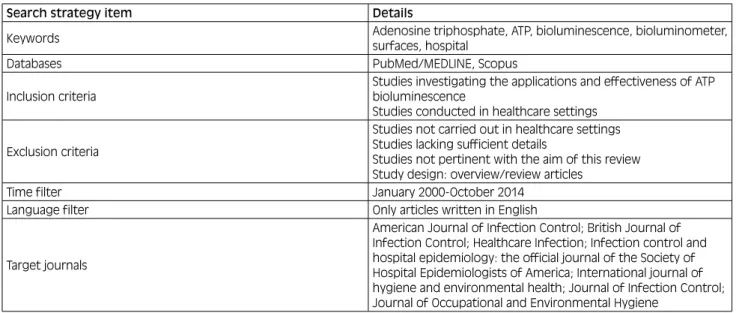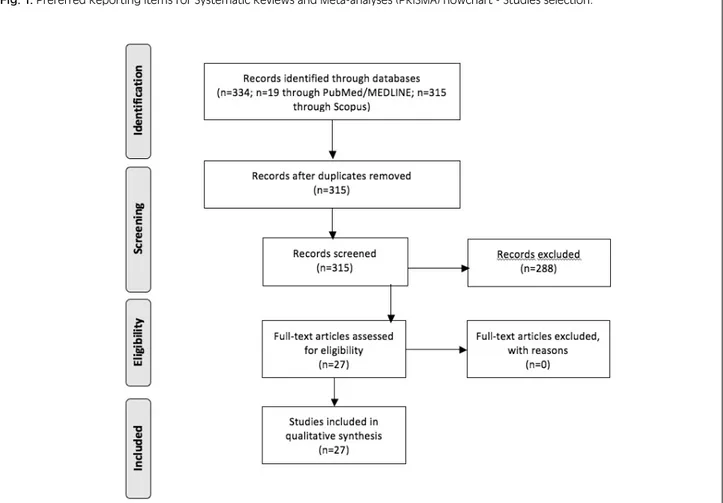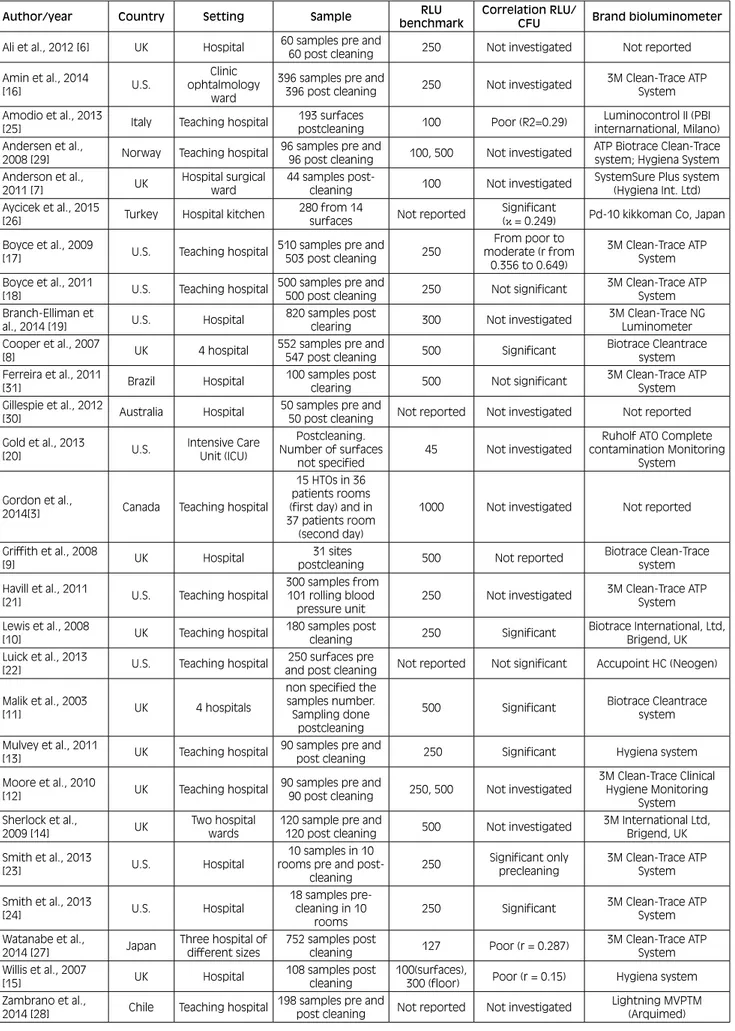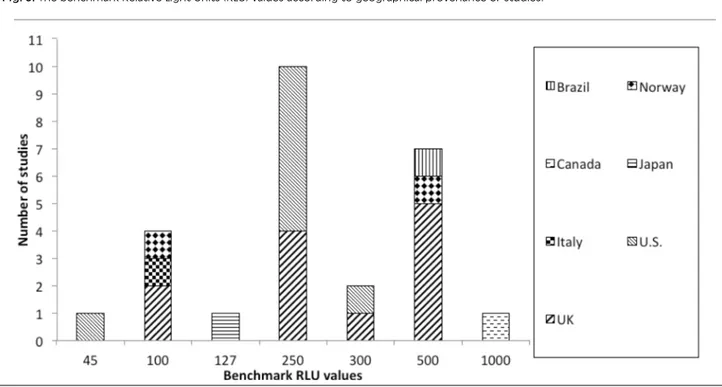Introduction. Contamination of hospital surfaces plays an important role in the transmission of several healthcare-associ-ated microorganisms, therefore methods for evaluating hospital surfaces’ cleaning gain particular importance. Among these, there are visual inspection, quantitative microbiology, fluorescent markers and adenosine triphosphate (ATP) bioluminescence. The latter seems to provide interesting features, detecting the pres-ence of ATP on surface (as Relative Light Units, RLU), a proxy of organic matter and microbial contamination. Several studies have investigated the effectiveness of this technology; with this research, we aim to summarize the most significant results. Methods. A systematic review was conducted. The keywords (namely, “ATP”, “bioluminescence”, “hospital” and “surfaces”) were searched in PubMed/MEDLINE and Scopus databases, in
order to find relevant data, from January 2000 to October 2014. After the selection, we globally considered 27 articles.
Results. Most of the studies were conducted in United Kingdom and in USA. Different threshold RLU benchmark values were identified by analyzed studies. Fourteen of these researches com-pared the ATP bioluminescence with microbiological methods, 11 identified a significant correlation between the two methods, although poor or not complete for 5.
Discussion. ATP bioluminescence is not a standardized methodol-ogy: each tool has different benchmark values, not always clearly defined. At the moment, we can say that the technique could be used to assess, in real time, hospital surfaces where cleanliness is required, but not sterility.
Original article
Effectiveness of ATP bioluminescence to assess hospital
cleaning: a review
N. NANTE 1, E. CERIALE 2, G. MESSINA 1, D. LENZI 3, P. MANZI 3
1 Department of Molecular and Developmental Medicine, Laboratory of Environmental Hygiene, University of Siena, Italy; 2 Post-Graduate School in Public Health, University of Siena, Italy; 3 Teaching Hospital “Le Scotte”, Hospital Direction, Siena, Italy
Keywords
ATP Bioluminescence • Hospital Surfaces • Healthcare-Associated Infections
Summary
Introduction
Healthcare-associated infections (HAIs) represent an important and widespread cause of morbidity and mor-tality among patients. Over the past decades, various sci-entific evidences have accumulated, indicating that con-tamination of hospital surfaces plays an important role in the transmission and diffusion of several healthcare-associated microorganisms [1, 2]. In particular, the hos-pital environment contributes to the transmission of sev-eral nosocomial pathogens, such as Clostridium difficile, methicillin-resistant Staphylococcus aureus (MRSA) and vancomycin-resistant Enterococcus (VRE) [2, 3]. These bacteria could survive in this setting for a vari-able period, from hours to days and, in some cases, even months, and could contaminate the surfaces or the medi-cal devices [4]. Consequently, pathogens could infect patients or contaminate the hands of healthcare staff and, then, patients [2].
Within this perspective, methods to assess hospital en-vironments cleaning can be considered an integral part of infections prevention and control programs. Among these, the most known and used are: visual inspection, microbial methods, fluorescent markers and adenosine triphosphate (ATP) bioluminescence. The latter meas-ures the presence of ATP on surfaces. The ATP biolumi-nescence consists in a swab, used to sample a
standard-ized area, which, subsequently, is placed in a tool that uses the firefly enzyme “luciferase” to catalyze the con-version of ATP in Adenosine Monophosphate (AMP): this reaction results into an emission of light which is detected by the bioluminometer and quantified in Rela-tive Light Unit (RLU). The presence of ATP on surface, obviously, is a proxy of organic matter and, consequent-ly, of microbial contamination. This method has been used in food industries since over 30 years. Its use in the health care environment is growing, but it is still contro-versial, in that different tools consider different thresh-old values, and, therefore, this technique seems not to be standardized.
Several studies investigated the effectiveness and also evaluated the practical application of this technique in this setting. The aim of this study was to qualitatively synthesize and discuss the most significant results and implications of the applications of ATP bioluminescence in healthcare settings, reviewing the most recent schol-arly literature.
Methods
We conducted a systematic review according to the “Preferred Reporting Items for Systematic Reviews and Meta-analyses” (PRISMA) guidelines [5]. The search
strategy consisted in a string of keywords such as ATP, bioluminescence, bioluminometer, hospital, health-care setting, surfaces, connected by proper Boolean operators. For this scope, the keywords were searched in PubMed/MEDLINE and Scopus databases, in order to find relevant data. Time filter was applied and only articles from January 2000 to October 2014 were con-sidered. Only articles written in English or for which an English translated text was available were included. Using Scopus we searched the keywords, selecting the option “all fields”, whilst for PubMed/MEDLINE medi-cal subject headings (MeSH) terms were used. All the searches as well as the screening were made by two re-searches EC and GM independently. Any disagreement was discussed until consensus was reached.
We included all types of studies, except: i) not peer-reviewed scholarly articles; ii) overview/review articles, which were excluded but scanned for including further potentially relevant studies, iii) articles not written in English language, iv) all laboratory studies, not conduct-ed in health care settings, and v) articles lacking suffi-cient details or not pertinent with the aim of our review. Further, selected target journals were hand-searched for increasing the chance of getting relevant articles. For en-suring a high-quality of the included studies, we did not search in the grey literature.
Table I reports our search strategy.
From each included study, we collected information about: i) the surname of the first author of the article and the year of publication; ii) the country where the research was carried out, iii) the setting in which the investigation was performed; iv) the samples used in the investigation; v) the RLU benchmark value discerning between clean and dirty surfaces (when investigated and reported), vi) the type of bioluminometers used, and vii) whether an eventual correlation between bioluminescence and mi-crobiological methods existed (in terms of correlation coefficients, such as Pearson’s coefficient, Spearman’s rank coefficient, concordance κ coefficient or R2). The
effect size of the correlation coefficient, when reported, was interpreted using the following rule of thumb: very high positive (or negative) if ranging from 0.90 to 1.00 (or ranging from -0.90 to -1.00): high positive (or nega-tive) if ranging from 0.70 to 0.90 (or ranging from -0.70 to -0.90), moderate positive (or negative) if ranging from 0.50 to 0.70 (or ranging from -0.50 to -0.70), low/poor positive (or negative) if ranging from 0.30 to 0.50 (or ranging from -0.30 to -0.50), and little/no correlation if ranging from 0.00 to 0.30 (or ranging from 0.00 to -0.30). In the case the exact correlation coefficient was not indicated, we reported whether the correlation was statistically significant or not, on the basis of the p-value. Data extraction was carried out by two reviewers inde-pendently. In case of discrepancy, any disagreement was solved by discussion until consensus was reached or a third reviewer was involved.
Results
Using PubMed/MEDLINE we found 19 studies, 4 of which were judged not relevant for our investigation and one was a review, examining 12 papers, already found by our research. The final number of studies considered using PubMed/MEDLINE was 14. Therefore, in Scopus we found 315 papers, and only 27 were useful for the review. As such, the final number of studied included in the review was 27 (Fig. 1).
Concerning the data extracted, all studies were con-ducted in health care settings. Most of them were carried out in United Kingdom (UK) (10/27) [6-15]; 9 of them were performed in USA [16-24], 1 in Italy [25], Turkey [26], Japan [27], Chile [28], Can-ada [3], Norway [29], Australia [30] and Brazil [31]. Eleven researches monitored the surfaces after clean-ing [3, 7, 9-11, 15, 19, 20, 25, 27, 31], one before [23], 13 both pre and post cleaning [6, 8, 12-14, 16-18, 22, 24, 28-30] and in the remaining two studies this information
Tab. I. Search strategy utilized in the current review.
Search strategy item Details
Keywords Adenosine triphosphate, ATP, bioluminescence, bioluminometer,
surfaces, hospital
Databases PubMed/MEDLINE, Scopus
Inclusion criteria
Studies investigating the applications and effectiveness of ATP bioluminescence
Studies conducted in healthcare settings Exclusion criteria
Studies not carried out in healthcare settings Studies lacking sufficient details
Studies not pertinent with the aim of this review Study design: overview/review articles
Time filter January 2000-October 2014
Language filter Only articles written in English
Target journals
American Journal of Infection Control; British Journal of Infection Control; Healthcare Infection; Infection control and hospital epidemiology: the official journal of the Society of Hospital Epidemiologists of America; International journal of hygiene and environmental health; Journal of Infection Control; Journal of Occupational and Environmental Hygiene
Discussion
Contamination of hospital surfaces plays an important role in the transmission of several healthcare-associated microorganisms. In this perspective, methods for evalu-ating hospital surfaces’ cleaning gain importance. Each of these methods show advantages and disadvantages, and directives indicating the most appropriate method to use in different health care settings do not exist. The ATP bioluminescence seems to provide interesting perspec-tives, detecting the presence of ATP on surfaces (as Rel-ative Light Units, RLU), a proxy of organic matter and microbial contamination. The present review showed the ATP bioluminescence is not a standardized method for assessing cleanliness; each tool had different benchmark values, ranging from 45 RLU to 1000 RLU. The most used values were 250 and 500 RLU. It is also interesting to note that for the same brand of bioluminometer differ-ent threshold values were considered.
The country where the studies were conducted may have influenced the choice of the RLU cutoff values, for ex-ample in the U.S. the most often used value correspond-ed to 500 RLU. The tool uscorrespond-ed in most studies was 3M Clean-Trace ATP System, following by Hygiena system and Biotrace Cleantrace System.
These differences among the benchmark values make difficult the comparisons between measurements carried out with different tools [15].
Fig. 1. Preferred Reporting Items for Systematic Reviews and Meta-analyses (PRISMA) flowchart - Studies selection.
was not reported [21, 26]. Twenty-three studies (85.2%) identified a RLU benchmark value, discerning between clean and dirty surfaces. This value corresponded to 250 for 10 studies [6, 10, 12, 13, 16-18 21, 23, 24], to 500 for 7 researches [8, 9, 11, 12, 14, 29, 31], to 100 for 4 studies [7, 15, 25, 29], to 300 for 2 studies [15, 19]; 127 [27], 1000 [3] and to 45 [20] for one study, respec-tively. Moore et al. [12] identified two threshold values: 250 and 500 RLU. Andersen et al. [29] used two differ-ent tools and, so, considered two differdiffer-ent values: 500 RLU for ATP Biotrace Cleantrace system and 100 for Hygiena System. Another paper considered as cutoff 100 RLU for several patient rooms surfaces and 300 RLU for floors [15]. Details about RLU threshold values for each type of bioluminometers are shown in Figure 2. Figure 3 shows the benchmark values according to geo-graphical provenance of studies.
Fourteen papers (51.8%) [8, 10, 11, 13, 15, 17, 18, 22-27, 31] compared the effectiveness of ATP bioluminescence to assess hospital surfaces’ cleaning with microbiologi-cal methods; in particular, these studies evaluated the correlation between RLU and Aerobic Colony Counts (ACC). Three of these studies have shown no correlation between the two compared methodologies [18, 22 31], whilst the remaining 11 have highlighted a correla-tion [8, 10, 11, 13, 15, 17, 23-27], although it is poor/ moderate according to 4 studies [15, 17, 25, 27] and one found only a pre-cleaning correlation [24].
Tab. II. General features of the studies.
Author/year Country Setting Sample benchmarkRLU Correlation RLU/CFU Brand bioluminometer Ali et al., 2012 [6] UK Hospital 60 samples pre and 60 post cleaning 250 Not investigated Not reported Amin et al., 2014
[16] U.S.
Clinic ophtalmology
ward
396 samples pre and
396 post cleaning 250 Not investigated 3M Clean-Trace ATP System Amodio et al., 2013
[25] Italy Teaching hospital postcleaning193 surfaces 100 Poor (R2=0.29) internarnational, Milano)Luminocontrol II (PBI Andersen et al.,
2008 [29] Norway Teaching hospital 96 samples pre and 96 post cleaning 100, 500 Not investigated ATP Biotrace Clean-Trace system; Hygiena System Anderson et al.,
2011 [7] UK Hospital surgical ward 44 samples post-cleaning 100 Not investigated SystemSure Plus system (Hygiena Int. Ltd) Aycicek et al., 2015
[26] Turkey Hospital kitchen 280 from 14 surfaces Not reported Significant (κ = 0.249) Pd-10 kikkoman Co, Japan Boyce et al., 2009
[17] U.S. Teaching hospital 510 samples pre and 503 post cleaning 250
From poor to moderate (r from 0.356 to 0.649) 3M Clean-Trace ATP System Boyce et al., 2011
[18] U.S. Teaching hospital 500 samples pre and 500 post cleaning 250 Not significant 3M Clean-Trace ATP System Branch-Elliman et
al., 2014 [19] U.S. Hospital 820 samples post clearing 300 Not investigated 3M Clean-Trace NG Luminometer Cooper et al., 2007
[8] UK 4 hospital 552 samples pre and 547 post cleaning 500 Significant Biotrace Cleantrace system Ferreira et al., 2011
[31] Brazil Hospital 100 samples post clearing 500 Not significant 3M Clean-Trace ATP System Gillespie et al., 2012
[30] Australia Hospital 50 samples pre and 50 post cleaning Not reported Not investigated Not reported Gold et al., 2013
[20] U.S. Intensive Care Unit (ICU)
Postcleaning. Number of surfaces
not specified 45 Not investigated
Ruholf ATO Complete contamination Monitoring
System Gordon et al.,
2014[3] Canada Teaching hospital
15 HTOs in 36 patients rooms (first day) and in 37 patients room
(second day)
1000 Not investigated Not reported Griffith et al., 2008
[9] UK Hospital postcleaning 31 sites 500 Not reported Biotrace Clean-Trace system Havill et al., 2011
[21] U.S. Teaching hospital
300 samples from 101 rolling blood
pressure unit 250 Not investigated
3M Clean-Trace ATP System Lewis et al., 2008
[10] UK Teaching hospital 180 samples post cleaning 250 Significant Biotrace International, Ltd, Brigend, UK Luick et al., 2013
[22] U.S. Teaching hospital and post cleaning250 surfaces pre Not reported Not significant Accupoint HC (Neogen) Malik et al., 2003
[11] UK 4 hospitals
non specified the samples number. Sampling done
postcleaning
500 Significant Biotrace Cleantrace system Mulvey et al., 2011
[13] UK Teaching hospital 90 samples pre and post cleaning 250 Significant Hygiena system Moore et al., 2010
[12] UK Teaching hospital 90 samples pre and 90 post cleaning 250, 500 Not investigated
3M Clean-Trace Clinical Hygiene Monitoring
System Sherlock et al.,
2009 [14] UK Two hospital wards 120 sample pre and 120 post cleaning 500 Not investigated 3M International Ltd, Brigend, UK Smith et al., 2013
[23] U.S. Hospital
10 samples in 10 rooms pre and
post-cleaning 250
Significant only
precleaning 3M Clean-Trace ATP System Smith et al., 2013 [24] U.S. Hospital 18 samples pre-cleaning in 10 rooms 250 Significant 3M Clean-Trace ATP System Watanabe et al.,
2014 [27] Japan Three hospital of different sizes 752 samples post cleaning 127 Poor (r = 0.287) 3M Clean-Trace ATP System Willis et al., 2007
[15] UK Hospital 108 samples post cleaning 100(surfaces), 300 (floor) Poor (r = 0.15) Hygiena system Zambrano et al.,
A large majority of studies was conducted in UK and in USA, probably because in these Countries there is a growing interest about environmental hospital hygiene and methods to assess it. Furthermore, it should be noted that among 14 studies investigating the correlation
be-tween ATP bioluminescence and microbiological meth-ods, 11 have found a significant correlation, although poor, or partial, for 5 papers. ATP bioluminescence would not seem to be a methodology very accurate in detecting bacteria. In addition, it provides a
quantifica-Fig. 2. The benchmark Relative Light Units (RLU) values according to the different brands of bioluminometers used in the studies included in the current review.
Fig. 3. The benchmark Relative Light Units (RLU) values according to geographical provenance of studies.
tion of all organic material, including bacteria, but it also identifies others organic matters such as urine, milk and blood, which is a limiting aspect of the methods and is rather difficult to overcome [10].
Another limitation of this technique could be the resi-dues of detergent or disinfectants on the surfaces [32], which may require rinsing of these surfaces before the use [33].
Despite of these considerations, some advantages of this technique can be listed, such as the possibility to pro-vide real-time results (within 20 seconds of sampling), its simplicity of use (which makes possible the adoption of the method not only by trained healthcare staff), and the quantitative results. The latter allows comparisons between pre- and post-cleaning or between different sur-faces.
Our study has a number of shortcoming that should be properly recognized. Despite the broad and systematic search, the main limitations of this study could be found in the selection of papers written only in English lan-guage and, therefore, in the possibility of having missed some relevant papers, which, considering the novelty of the technique, could be found, instead, in the “grey lit-erature”. On the other hand, it should be expected that the quality of the latter papers would be inferior to those present in the scholarly peer-reviewed indexed literature. Concerning the main implications of the current study, we can conclude that the use of this technique could produce better results after a proper validation/stan-dardization. To achieve this aim a multi-phase approach should be followed: i) to clarify the methods of sanitiz-ing or disinfectsanitiz-ing performed on each surfaces before the controls made with the bioluminometer; ii) to select the most appropriate surfaces where the analysis have to be conducted (for example “high risk objects” such as toilet seats, basins, door handles); iii) to choose the bioluminometer among the different brands available; iv) to calibrate the instruments studying the correlation between CFU and RLU, identifying the best threshold value (higher sensitivity and specificity) [33] which dis-criminates between clean and dirt surfaces.
Conclusions
In conclusion, the ATP bioluminescence could be con-sidered a practical, useful method to assess hospital hy-giene, performing better than visual inspection (namely, Bacharach scale, bassoumeter, and glossmeter), if prop-erly adopted, also being aware of its possible limits.
Acknowledgements
The authors thank Dr Nicola Bragazzi for his helpful suggestions.
The authors declare that there is no conflict of interest regarding the publication of this paper.
Authors’ contributions
NN conceived the research. EC and GM researched and analyzed the study using for review and evaluated the results. EC, GM and DL performed the data quality con-trol. EC, GM and PM wrote the manuscript. PM super-vised the research. All Authors resuper-vised the manuscript and gave their contribution to improve the paper. All au-thors read and approved the final manuscript.
References
[1] Boyce JM. Environmental contamination makes an important contribution to hospital infection. J Hosp Infect 2007;65:50-4. [2] Weber DJ, Rutala WA. Understanding and preventing
trans-mission of healthcare-associated pathogens due to the con-taminated hospital environment. Infect Control Hosp Epidemiol 2013;34:449-52.
[3] Gordon L, Bruce N, Suh KN, Roth V. Evaluating and opera-tionalizing an environmental auditing program: a pilot study. Am J Infect Control 2014;42:702-7.
[4] Messina G, Ceriale E, Lenzi D, Burgassi S, Azzolini E, Manzi P. Environmental contaminants in hospital settings and progress in disinfecting techniques. Biomed Res Int 2013;2013:429780. [5] Liberati A, Altman DG, Tetzlaff J, Mulrow C, Gøtzsche PC,
Io-annidis JP, Clarke M, Devereaux PJ, Kleijnen J, Moher D. The PRISMA statement for reporting systematic reviews and meta-analyses of studies that evaluate health care interventions: ex-planation and elaboration. PLoS Med 2009;6(7):e1000100. [6] Ali S, Moore G, Wilson APR. Effect of surface coating and
fin-ish upon the cleanability of bed rails and the spread of Staphy-lococcus aureus. J Hosp Infect 2012;80:192-8.
[7] Anderson RE, Young V, Stewart M, Robertson C, Dancer SJ. Cleanliness audit of clinical surfaces and equipment: Who cleans what? J Hosp Infect 2011;78:178-81.
[8] Cooper RA, Griffith CJ, Malik RE, Obee P, Looker N. Monitor-ing the effectiveness of cleanMonitor-ing in four British hospitals. Am J Infect Control 2007;35:338-41.
[9] Griffith CJ, Cooper RA, Gilmore J, Davies C, Lewis M. An evaluation of hospital cleaning regimes and standards. J Hosp Infect 2000;45:19-28.
[10] Lewis T, Griffith C, Gallo M, Weinbren M. A modified ATP benchmark for evaluating the cleaning of some hospital envi-ronmental surfaces. J Hosp Infect 2008;69:156-63.
[11] Malik RE, Cooper RA, Griffith CJ. Use of audit tools to evalu-ate the efficacy of cleaning systems in hospitals. Am J Infect Control 2003;31:181-7.
[12] Moore G, Smyth D, Singleton J, Wilson P. The use of adenosine triphosphate bioluminescence to assess the efficacy of a modi-fied cleaning program implemented within an intensive care set-ting. Am J Infect Control 2010;38:617-22.
[13] Mulvey D, Redding P, Robertson C, Woodall C, Kingsmore P, Bedwell D, Dancer SJ. Finding a benchmark for monitoring hospital cleanliness. J Hosp Infect 2011;77:25-30.
[14] Sherlock O, O’Connell N, Creamer E, Humphreys H. Is it really clean? An evaluation of the efficacy of four methods for deter-mining hospital cleanliness. J Hosp Infect 2009;72:140-6. [15] Willis C, Morley R, Westbury J, Greenwood M, Pallett A.
Eval-uation of ATP bioluminescence swabbing as a monitoring and training tool for effective hospital cleaning. Br J Infect Contr 2007;8:17-21.
[16] Amin SR, Folkert CM, Erie JC. Assessing the effectiveness of surface cleaning methods in intravitreal injection procedure rooms. Ophthalmolog. 2014;121:276-82.
O, Rizvani R. Monitoring the effectiveness of hospital cleaning practices by use of an adenosine triphosphate bioluminescence assay. Infect Control Hosp Epidemiol 2009;30:678-84. [18] Boyce JM, Havill NL, Havill HL, Mangione E, Dumigan DG,
Moore BA. Comparison of fluorescent marker systems with 2 quantitative methods of assessing terminal cleaning practices. Infect Control Hosp Epidemiol 2011;32:1187-93.
[19] Branch-Elliman W, Robillard E, McCarthy Jr G, Gupta K. Di-rect feedback with the ATP luminometer as a process improve-ment tool for terminal cleaning of patient rooms. Am J Infect Control 2014;42:195-7.
[20] Gold KM, Hitchins VM. Cleaning assessment of disinfectant cleaning wipes on an external surface of a medical device con-taminated with artificial blood or Streptococcus pneumoniae. Am J Infect Control 2013;41:901-7.
[21] Havill NL, Havill HL, Mangione E, Dumigan DG, Boyce JM. Cleanliness of portable medical equipment disinfected by nurs-ing staff. Am J Infect Control 2011;39:602-4.
[22] Luick L, Thompson PA, Loock MH, Vetter SL, Cook J, Guerre-ro DM. Diagnostic assessment of different enviGuerre-ronmental clean-ing monitorclean-ing methods. Am J Infect Control 2013;41:751-2. [23] Smith PW, Gibbs S, Sayles H, Hewlett A, Rupp ME, Iwen PC.
Observations on hospital room contamination testing. Health-care Infection 2013;18:10-3.
[24] Smith PW, Sayles H, Hewlett A, Cavalieri J, Gibbs SG, Rupp ME. A study of three methods for assessment of hospital envi-ronmental cleaning. Healthcare Infection 2013;18:80-5. [25] Amodio E, Cannova L, Villafrate MR, Merendino AM, Aprea
L, Calamusa G. Analytical performance issues: comparison of ATP bioluminescence and aerobic bacterial count for evaluat-ing surface cleanliness in an Italian hospital. J Occup Environ Hyg 2014;11:D23-D7.
[26] Aycicek H, Oguz U, Karci K. Comparison of results of ATP bioluminescence and traditional hygiene swabbing methods for the determination of surface cleanliness at a hospital kitchen. Int J Hyg Environ Health 2006;209:203-6.
[27] Watanabe R, Shimoda T, Yano R, Hayashi Y, Nakamura S, Matsuo J, Yamaguchi H. Visualization of hospital cleanliness in three Japanese hospitals with a tendency toward long-term care. BMC Res Notes 2014;7.
[28] Zambrano AA, Jones A, Otero P, Ajenjo MC, Labarca JA. As-sessment of hospital daily cleaning practices using ATP biolu-minescence in a developing country. Braz J Infect Dis 2014; 18:675-7.
[29] Andersen BM, Rasch M, Kvist J, Tollefsen T, Lukkassen R, Sandvik L, Welo A. Floor cleaning: effect on bacteria and or-ganic materials in hospital rooms. J Hosp Infect 2009;71:57-65. [30] Gillespie E, Wilson J, Lovegrove A, Scott C, Abernethy M, Kot-sanas D, Stuart RL. Environment cleaning without chemicals in clinical settings. Am J Infect Control 2013;41:461-3.
[31] Ferreira AM, de Andrade D, Rigotti MA, Ferreira MVF. Condi-tion of cleanliness of surfaces close to patients in an intensive care unit. Condições de limpeza de superfícies próximas ao pa-ciente, em uma unidade de terapia intensive. Rev. Latino-Am. Enfermagem 2011;19:557-64.
[32] Boyce JM, Havill NL, Lipka A, Havill H, Rizvani R. Variations in hospital daily cleaning practices. Infect Control Hosp Epide-miol 2010;31:99-101.
[33] Manzi P, Barbini P, Ricci N,Fidone G, Pompili O, Donatelli E. Validazione del processo di pulizia in aree critiche mediante bioluminometria. L’Ospedale 2012;2:64-71.
n Received on December 18, 2016. Accepted on February 17, 2017. n Correspondence: Gabriele Messina, Research Professor of Public
Health, University of Siena, Department of Molecular and Devel-opmental Medicine, via A. Moro 2, Siena, 53100 Italy - Tel.+39 0577 234139 - Fax +39 0577 234090 - E-mail: gabriele.messina@ unisi.it



